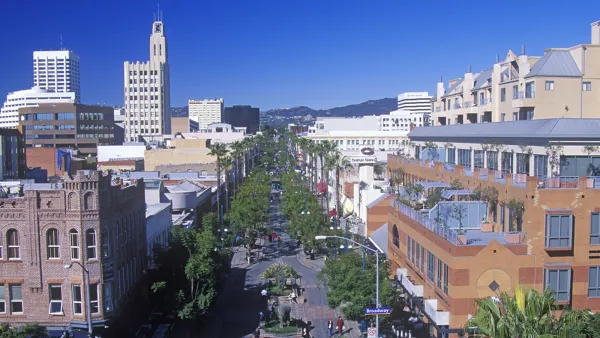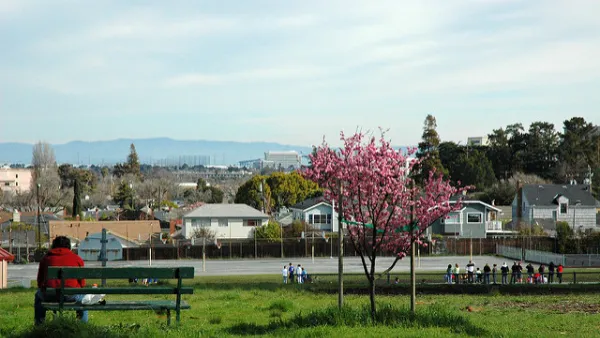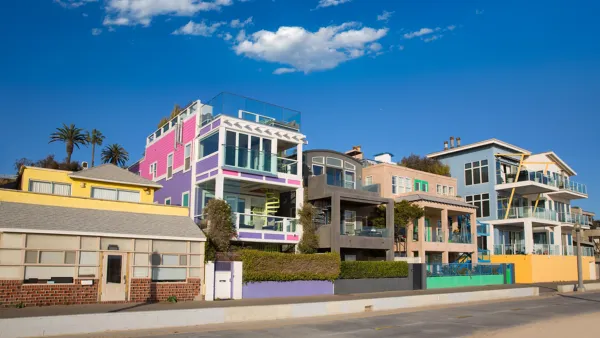The city of Santa Monica increased in population by 6,500 between 1960 and 2010, while the rest of Los Angeles County grew by 60 percent over the same period. A debate over a new downtown plan that includes more housing was never going to be simple.

Christopher Hawthorne, architecture critic for the Los Angeles Times, provides coverage of the city of Santa Monica's ongoing Downtown Community Plan process, and the "gulf" between two entrenched camps regarding the politics of growth, housing, and development.
On one side there's "the slow-growth or even no-growth faction," and on the other there's the "pro-growth and pro-housing advocates." Hawthorne cites Santa Monica City Manager Rick Cole to describe how the political debate in the desirable coastal city played out in the defeat of slow growth measure LV on the November 2016 citywide ballot and in the debate leading up to the DCP's final steps. "The philosophical differences between the two camps have been thrown into sharp relief," writes Hawthorne.
But according to Cole, something surprising happened as the DCP wound its way through the approval process, first at the planning commission and then in front of the full city council. Santa Monica, he argues, managed to build a bridge across the yawning growth gap.
Hawthorne also gives Cole a chance to speak on some of the progressive land use regulation practices included in the proposed plan, including, for example, the elimination of parking minimums and approvals for three big projects already in the pipeline. Hawthorne also provides his critiques of the plan, including its decision to lower the height limits along the northern edge of downtown and its reliance on a 30 percent affordable housing requirements, which some pro-development advocates say "will give developers an incentive to steer clear of housing altogether in downtown Santa Monica."
In the end, however, Hawthorne writes this column as a critique of Cole's pitch for a "grand bargain," or a balanced approach to the construction of new housing.
It was surprising, then, to see an article by Jason Islas for Santa Monica Next, published the day before the city council's vote on the DCP, citing an email from Cole asking the council to "assess how 1000-1500 new units of market rate and affordable units being constructed in our Downtown in the next couple of years (unaffected by the DCP) will be viewed by the various community stakeholders." Islas is obviously skeptical about the plan's ability to live up to its billing as a grand bargain: "The Downtown Community Plan, based on Cole’s email, seems to be a recapitulation of the policies that have turned Santa Monica into a city increasingly inaccessible to only wealthy people or the few lower-income people who get into the scarce affordable units that get built each year."
The debate over housing and growth, for now, is over, as the city approved the plan, according to a Tweet sent by Rick Cole last night.
Downtown Community Plan unanimously approved by City Council.@santamonicacity@DTSantaMonica@StreetsblogLA@HawthorneLAT@CurbedLA pic.twitter.com/UxzF1cPiB4
— Rick Cole (@SaMoCole) July 26, 2017
FULL STORY: Santa Monica's 'grand bargain' on growth and housing: A model for other cities?

Analysis: Cybertruck Fatality Rate Far Exceeds That of Ford Pinto
The Tesla Cybertruck was recalled seven times last year.

National Parks Layoffs Will Cause Communities to Lose Billions
Thousands of essential park workers were laid off this week, just before the busy spring break season.

Retro-silient?: America’s First “Eco-burb,” The Woodlands Turns 50
A master-planned community north of Houston offers lessons on green infrastructure and resilient design, but falls short of its founder’s lofty affordability and walkability goals.

Test News Post 1
This is a summary

Analysis: Cybertruck Fatality Rate Far Exceeds That of Ford Pinto
The Tesla Cybertruck was recalled seven times last year.

Test News Headline 46
Test for the image on the front page.
Urban Design for Planners 1: Software Tools
This six-course series explores essential urban design concepts using open source software and equips planners with the tools they need to participate fully in the urban design process.
Planning for Universal Design
Learn the tools for implementing Universal Design in planning regulations.
EMC Planning Group, Inc.
Planetizen
Planetizen
Mpact (formerly Rail~Volution)
Great Falls Development Authority, Inc.
HUDs Office of Policy Development and Research
NYU Wagner Graduate School of Public Service




























